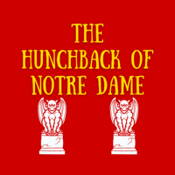
The Hunchback of Notre Dame
Musical
Writers:Overview
Synopsis
What makes a monster and what makes a man? This is the central theme of The Hunchback of Notre Dame, a sweeping, grand-scale musical from Disney Theatrical. Based on the 1996 Disney film and Victor Hugo’s 1831 novel, The Hunchback of Notre Dame tells the story of Quasimodo, the hunchbacked bell-ringer of Notre Dame, and his desire to one day be a part of the outside world. When he summons the courage to attend the Feast of Fools, he meets Esmeralda, a compassionate gypsy who protects him from an angry mob. But at the same time, Quasimodo’s master, the archdeacon Dom Claude Frollo, and the new captain of the guard, Phoebus de Martin, fall in love with the beautiful girl. Adding to Quasimodo’s struggle is his punishment and derision from Frollo, following years of psychological abuse, and the danger posed by the gypsies, who are willing to kill any outsiders who venture into their secret hideout. But before Paris is burned to the ground, will Quasimodo be able to save Esmeralda from Frollo’s lust and anger? Will she return Quasimodo’s affection? Who is the true monster of Notre Dame?
Show Information
Context
The first Walt Disney Theatrical musical produced outside of the United States, The Hunchback of Notre Dame originally premiered in Germany as Der Glockner von Notre Dame (The Bellringer of Notre Dame) in 1999. Before closing in 2002, it had a successful run at the Musicaltheater Berlin. While much of the music from the 1996 Disney film was retained, it was a much more dark and gothic tone than the original. But even though successful, it wasn’t until 2008 that Stephen Schwartz confirmed
to read the context for The Hunchback of Notre Dame and to unlock other amazing theatre resources!Plot
As the lights rise, cloaked figures file onto the stage, guided by the chimes of the bells of Notre Dame. As a chorus, they begin to sing a Latin liturgy (“Olim”). The music swells into the opening narration of “The Bells of Notre Dame” as the cloaked figures reveals themselves as the ensemble of The Hunchback of Notre Dame. Together, and with featured singers, they introduce us to Dom Claude Frollo and his younger brother Jehan, orphan boys who were raised within the church of Notre Dame.
to read the plot for The Hunchback of Notre Dame and to unlock other amazing theatre resources!Characters
| Name | Part Size | Gender | Vocal Part |
|---|---|---|---|
|
Lead |
Male |
Tenor |
|
|
Lead |
Male |
Baritone |
|
|
Lead |
Female |
Mezzo-Soprano |
|
|
Supporting |
Male |
Tenor, Baritone |
|
|
Supporting |
Male |
Tenor, Baritone |
|
|
Supporting |
Male |
Tenor |
|
|
Featured |
Male |
Baritone |
|
|
Featured |
Female |
Mezzo-Soprano |
|
|
Featured |
Male |
Baritone |
|
|
Featured |
Female |
Spoken |
|
|
Featured |
Male |
Spoken |
|
|
Featured |
Male |
Spoken |
|
|
Featured |
Female |
Spoken |
|
|
Ensemble |
Either Gender |
|
|
|
Ensemble |
Either Gender |
|
|
|
Ensemble |
Either Gender |
|
|
|
Ensemble |
Either Gender |
|
|
|
Ensemble |
Male |
|
|
|
Ensemble |
Either Gender |
|
Songs
Act One
"The Bells of Notre Dame" - Frollo, Jehan, Father Dupin, & Congregation
"Sanctuary" - Frollo & Quasimodo
"Out There" - Quasimodo
*"Topsy Turvy (Part 1)" - Clopin, Quasimodo, & Congregation
"Rest and Recreation" - Phoebus, Frollo & Congregation
*"Rhythm of the Tambourine" - Clopin, Esmeralda, Phoebus, Frollo, Quasimodo, & Congregation
*"Topsy Turvy (Part 2)" - Clopin & Congregation
"Into Notre Dame" - Frollo, Quasimodo, Esmeralda, & Congregation
"God Help the Outcasts" - Esmeralda & Congregation
"Top of the World" - Esmeralda, Quasimodo, & Congregation
*"The Tavern Song" (Thai Mol Piyas) - Clopin, Esmeralda, Frollo, Congregation, & Gypsies
"Heaven's Light" - Quasimodo
"Hellfire" - Frollo & Congregation
"Esmeralda" - Frollo, Phoebus, Quasimodo, & Congregation
Act Two
"Entr'acte" - Congregation
"Flight Into Egypt" - Saint Aphrodisius, Quasimodo, & Congregation
"The Court of Miracles" - Clopin & Gypsies
"In a Place of Miracles" - Phoebus, Esmeralda, Quasimodo, Clopin, & Gypsies
"Justice in Paris" - Congregation
"Someday" - Esmeralda & Phoebus
"While the City Slumbered" - Congregation
"Made of Stone" - Quasimodo & Congregation
"Finale" - Frollo, Phoebus, Quasimodo, Esmeralda, Clopin, & Congregation
A song with an asterisk (*) before the title indicates a dance number; a character listed in a song with an asterisk (*) by the character's name indicates that the character exclusively serves as a dancer in this song, which is sung by other characters.
Monologues
Scenes
Key Terms
An adaptation is a reworking of a story from one medium or cultural context into another, such as turning a novel into a play or updating a classic play’s setting. Adaptations often reinterpret themes, characters, and style for new audiences. They can range from faithful recreations to bold reimaginings.
An “I Want Song” is a number, usually placed early in a musical, where a main character expresses their deepest desire or ambition. This song sets the character’s journey in motion and gives the audience a clear emotional stake in the story. It has become one of the most recognizable and enduring conventions of musical theatre structure.
A recurring musical theme associated with a particular character, idea, or emotion. Frequently used in opera and musical theatre, leitmotifs help reinforce narrative continuity and emotional cues for the audience.
Videos
Quizzes
Themes, Symbols & Motifs
Sorry! We do not currently have learning modules for this guide.
Quote Analysis
Sorry! We do not currently have learning modules for this guide.
